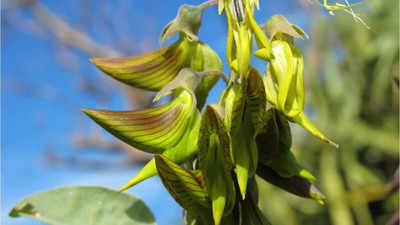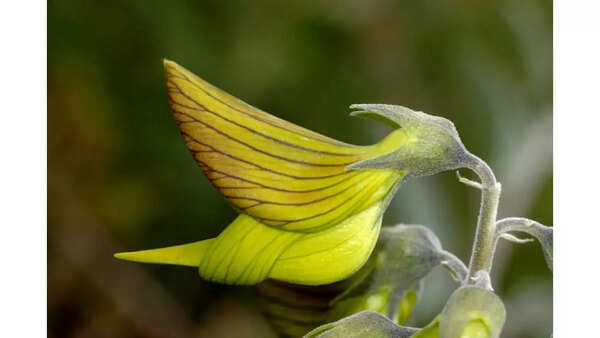Trending
This story is from January 24, 2024
A plant that mimics hummingbird to save itself from insects
This article discusses the concept of Batesian mimicry and simulacrum, as well as the role of Michael Whitehead in shaping perceptions of Crotalaria Cunninghamii. The plant's unique hummingbird-like appearance is an adaptation for bird pollination, specifically attracting honeyeaters. Aboriginal communities also use the plant for medicinal purposes

(Source: Pexels)
In the realm of nature, visual appeal serves as a means of self-defense or survival for various living species. From tiny caterpillars to brightly coloured birds, this strategy is employed to evade predators. Surprisingly, even plants, seemingly immobile and safe, possess a unique defense mechanism. One such example is the Crotalaria Cunninghamii, a wildflower that strikingly resembles a gathering of hummingbirds on a plant stem.
Discovery and initial speculations
Months ago, a Reddit thread sparked curiosity when a user shared a captivating image of the delicate leaves of the Crotalaria Cunninghamii. This plant, believed to belong to the legume family and native to Central and Western Australia, raised questions about its peculiar appearance. Could it be an optical illusion or a result of evolutionary play?
Experts proposed the concept of Batesian mimicry, a tactic used by some plants and animals to deceive predators by appearing strange, dangerous, or unappealing. Simulacrum, a psychological phenomenon causing humans to identify resemblances among plants, was also suggested. Moreover, some argued that the plant's hummingbird-like appearance aimed at attracting insects and pollinators.

Remarkably, researchers discovered a dearth of studies on Crotalaria Cunninghamii, attributed to its remote desert habitat in Australia. This lack of scientific publications led to a broader exploration of the plant's features and its role in the ecosystem.
Ultimately, researchers concluded that the plant's distinctive hummingbird-like features were likely an adaptation for consistent bird pollination
The intrigue surrounding Crotalaria Cunninghamii was further intensified by Michael Whitehead, a plant ecologist based at the University of Melbourne. His clever photography angles and styles played a role in shaping perceptions. A Reddit post included an alternative angle of the plant, revealing a stark contrast to its hummingbird resemblance.

A 2016 study highlighted the correlation between bird pollination traits and plant shape, emphasising the plant's preference for birds like honeyeaters. Notably, Crotalaria Cunninghamii's habitat lacks hummingbirds, pointing to an adaptive strategy for reproduction by attracting unique bird pollinators.
The plant, part of a genus with over 500 species worldwide, remains an intriguing subject of study. Another remarkable example, "Pecteilis radiata," an orchid resembling an egret in flight, can be found in various countries, including Japan, China, Russia, and Korea.
Named after the Australian botanist Allan Cunningham, who scientifically described the plant between 1816 and 1839, Crotalaria Cunninghamii holds cultural significance. Aboriginal communities utilize its sap for treating eye infections, showcasing its potential medicinal value.
In unraveling the mysteries of Crotalaria Cunninghamii, researchers delve into the intricate world of mimicry, adaptation, and pollination strategies. Beyond its striking hummingbird-like appearance, the plant embodies a rich botanical heritage, offering insights into the coexistence of diverse species in the vast tapestry of nature.
Discovery and initial speculations
Months ago, a Reddit thread sparked curiosity when a user shared a captivating image of the delicate leaves of the Crotalaria Cunninghamii. This plant, believed to belong to the legume family and native to Central and Western Australia, raised questions about its peculiar appearance. Could it be an optical illusion or a result of evolutionary play?
Experts proposed the concept of Batesian mimicry, a tactic used by some plants and animals to deceive predators by appearing strange, dangerous, or unappealing. Simulacrum, a psychological phenomenon causing humans to identify resemblances among plants, was also suggested. Moreover, some argued that the plant's hummingbird-like appearance aimed at attracting insects and pollinators.

(Source: File Photo)
Remarkably, researchers discovered a dearth of studies on Crotalaria Cunninghamii, attributed to its remote desert habitat in Australia. This lack of scientific publications led to a broader exploration of the plant's features and its role in the ecosystem.
Ultimately, researchers concluded that the plant's distinctive hummingbird-like features were likely an adaptation for consistent bird pollination
. Specifically, the flowers' long keel on the petals favored bird pollinators such as honeyeaters and rodents.
The intrigue surrounding Crotalaria Cunninghamii was further intensified by Michael Whitehead, a plant ecologist based at the University of Melbourne. His clever photography angles and styles played a role in shaping perceptions. A Reddit post included an alternative angle of the plant, revealing a stark contrast to its hummingbird resemblance.

(Source: Wikipedia)
A 2016 study highlighted the correlation between bird pollination traits and plant shape, emphasising the plant's preference for birds like honeyeaters. Notably, Crotalaria Cunninghamii's habitat lacks hummingbirds, pointing to an adaptive strategy for reproduction by attracting unique bird pollinators.
The plant, part of a genus with over 500 species worldwide, remains an intriguing subject of study. Another remarkable example, "Pecteilis radiata," an orchid resembling an egret in flight, can be found in various countries, including Japan, China, Russia, and Korea.
Named after the Australian botanist Allan Cunningham, who scientifically described the plant between 1816 and 1839, Crotalaria Cunninghamii holds cultural significance. Aboriginal communities utilize its sap for treating eye infections, showcasing its potential medicinal value.
In unraveling the mysteries of Crotalaria Cunninghamii, researchers delve into the intricate world of mimicry, adaptation, and pollination strategies. Beyond its striking hummingbird-like appearance, the plant embodies a rich botanical heritage, offering insights into the coexistence of diverse species in the vast tapestry of nature.
End of Article
FOLLOW US ON SOCIAL MEDIA








